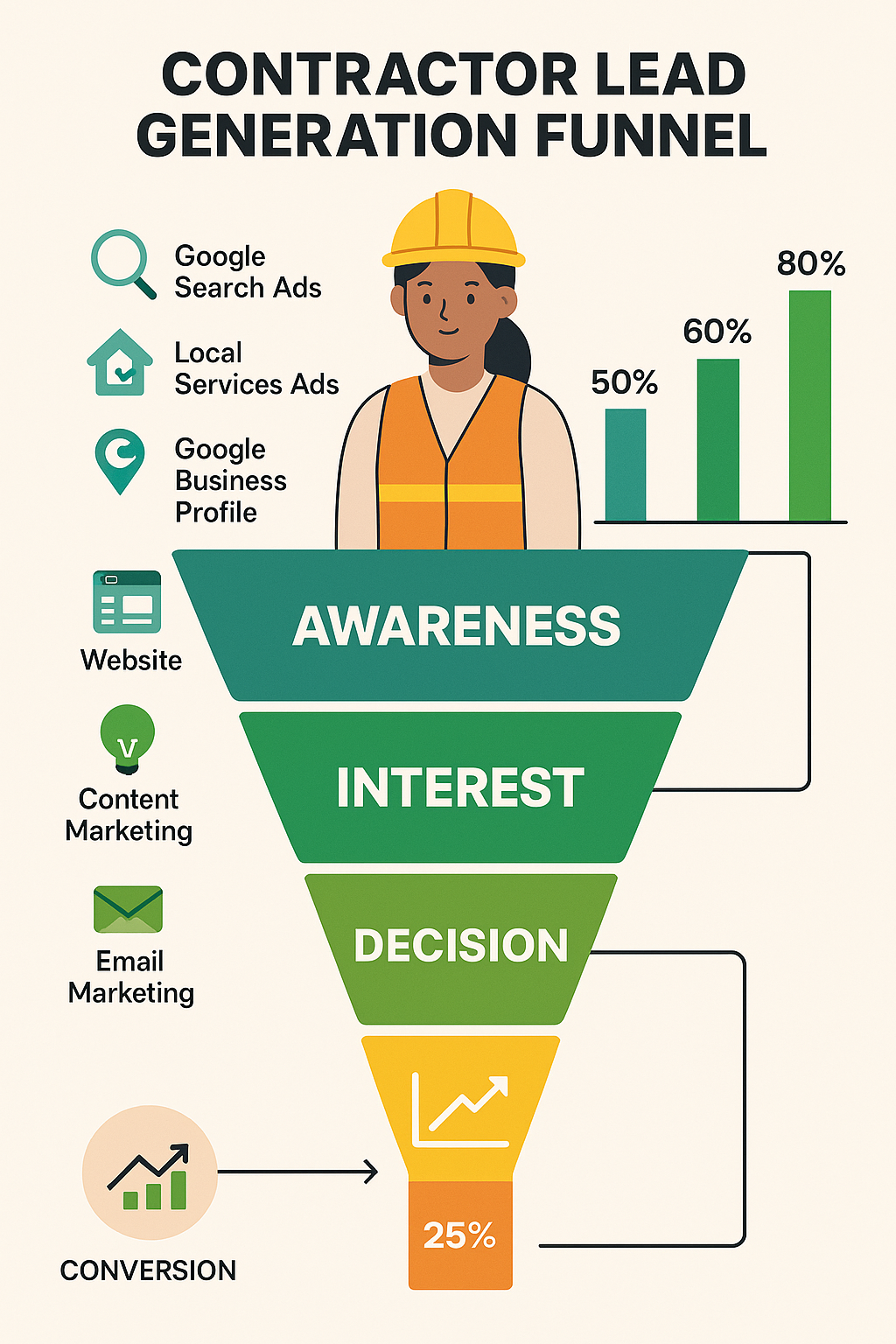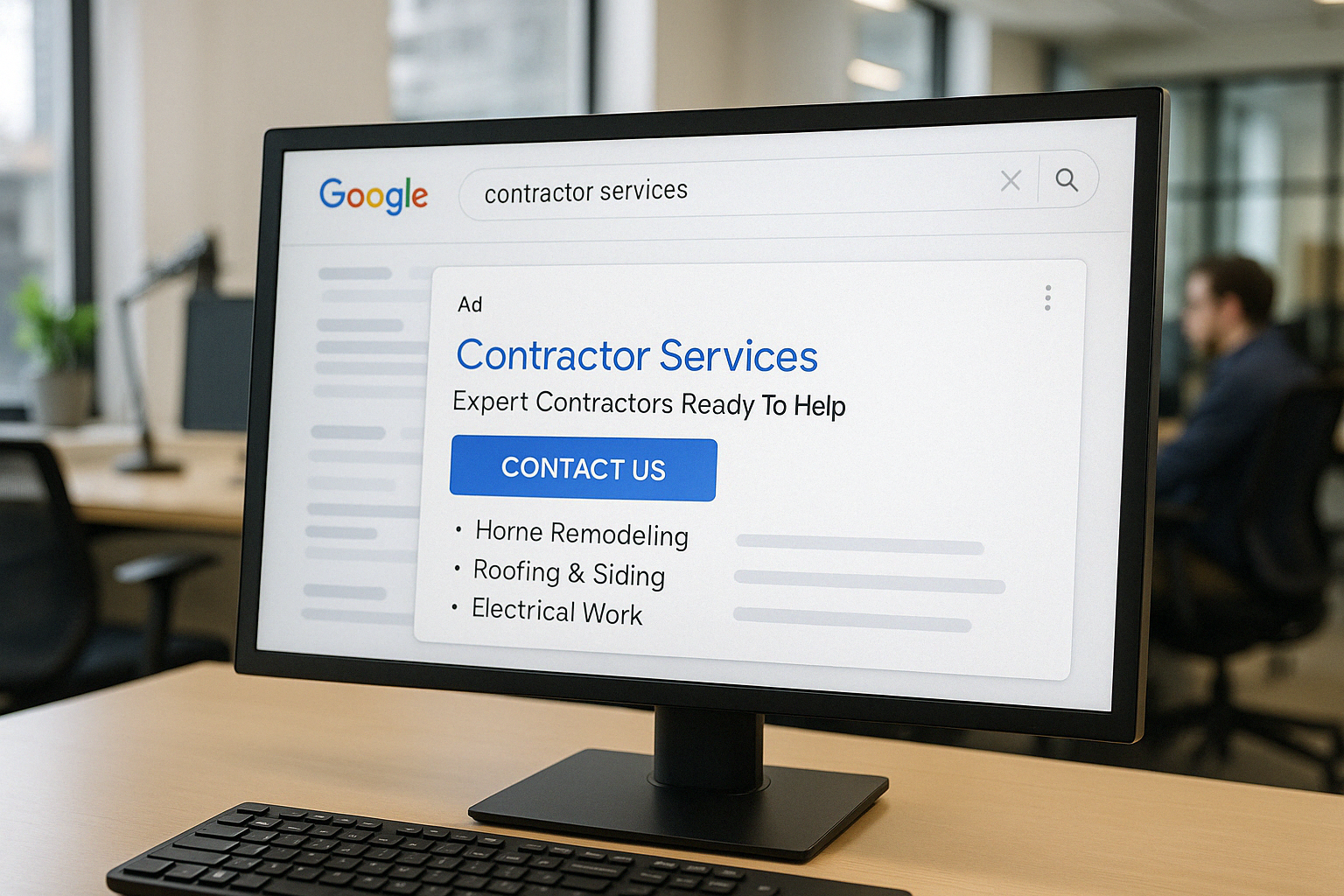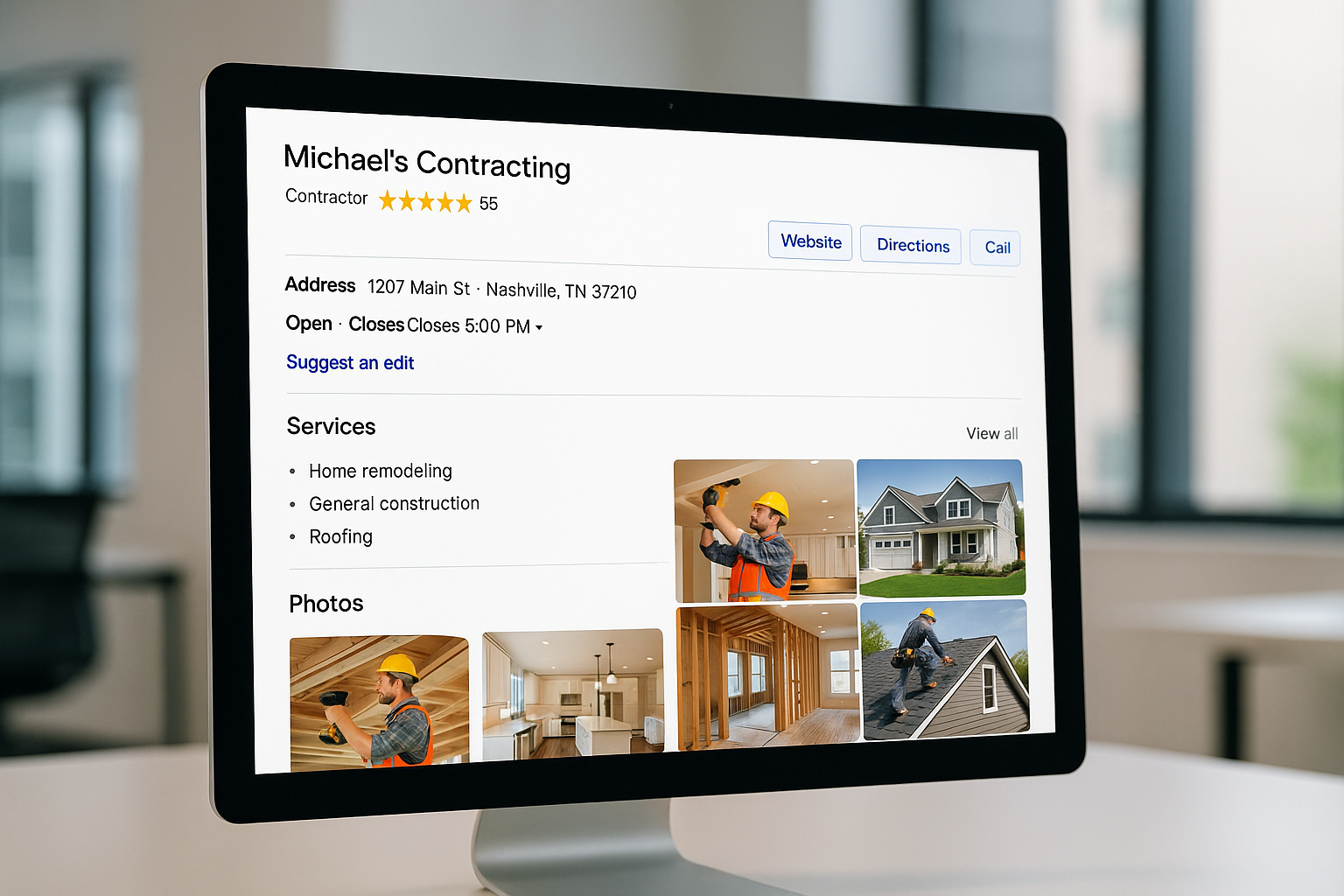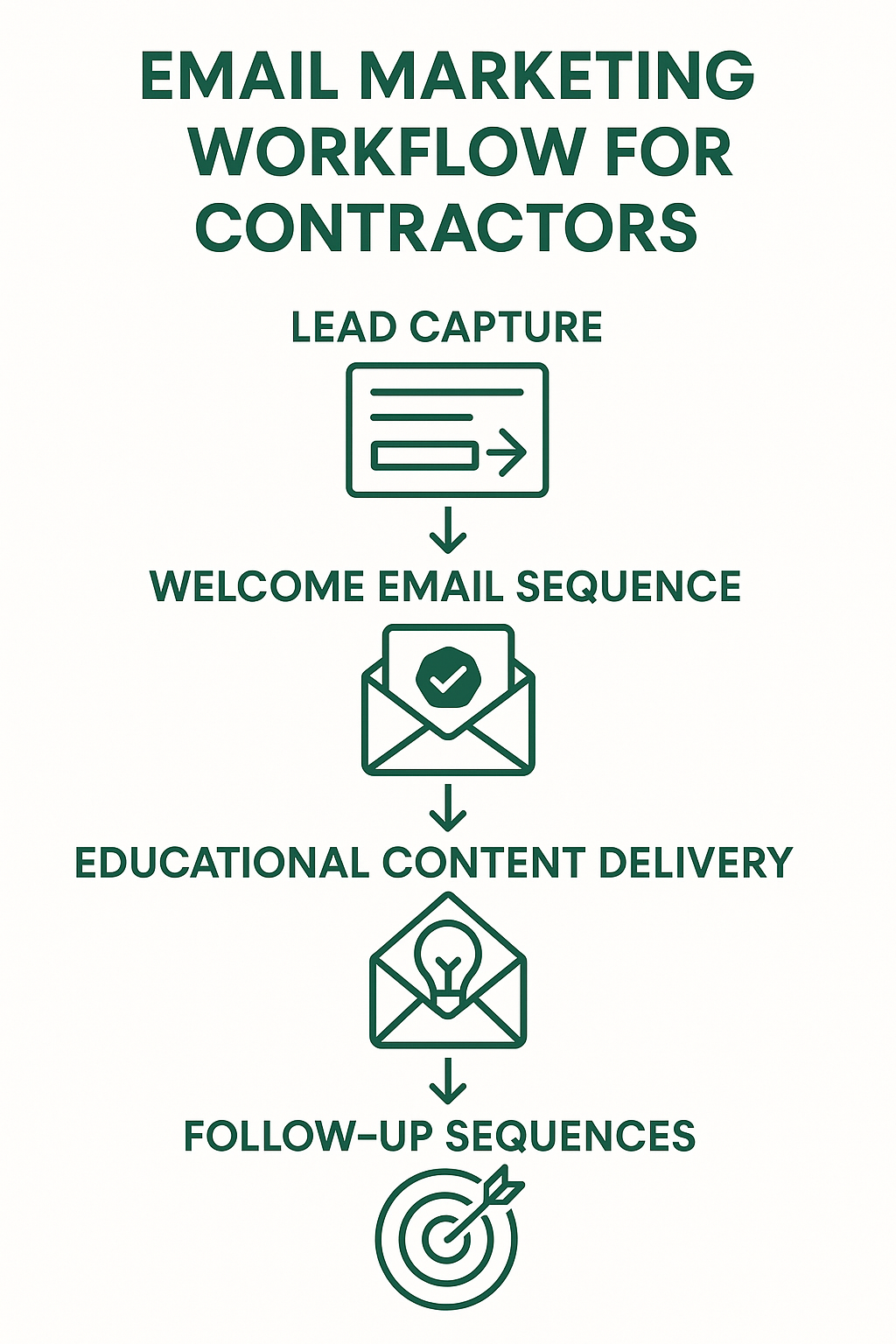Where the Best Contractor Leads Come From
As we enter 2025, the demand for professional contractor services remains strong, making an effective lead generation strategy more important than ever.
Contractor lead generation is the process of attracting and converting prospects into potential clients for your construction or home service business. If you’re looking for a quick answer about where to get quality leads, here are the most effective sources:
- Google Search Ads (PPC) – Immediate visibility for high-intent searches
- Local Service Ads – “Google Guaranteed” leads with pay-per-lead pricing
- Google Business Profile – Free leads from local search visibility
- Your Optimized Website – Converts visitors through strategic design and SEO
- Content Marketing – Builds authority and attracts long-term organic traffic
- Email Marketing – Nurtures existing relationships for repeat business
In the construction and home services industry, finding a consistent source of quality leads can mean the difference between feast and famine. Every contractor knows the frustration of unreliable lead flow
— one month you’re turning away work, the next you’re scrambling to fill the schedule.
“Most construction companies spend an average of $280 per lead,” according to industry data, yet many contractors struggle to generate a positive return on that investment. The challenge isn’t just getting more leads — it’s getting the right leads that convert into profitable projects.
Successful contractors don’t rely on just one lead source. They build a diversified lead generation system that combines immediate results (like paid ads) with long-term strategies (like SEO and content marketing).
While third-party lead platforms offer quick access to potential clients, they often come with significant drawbacks including high competition, variable lead quality, and lack of brand control. The most sustainable approach is building your own lead generation assets that you control.
Let’s explore where the most successful contractors are finding their best leads in today’s digital landscape.

Key terms for contractor lead generation:
1. Invest in Google Search Ads (PPC) for Immediate Contractor Lead Generation
Need leads now? Google Search Ads (Pay-Per-Click or PPC) are your fastest path to new business. These ads appear right at the top of search results when potential customers are actively searching for services like yours – exactly when they’re ready to hire.

What makes PPC so powerful for contractor lead generation is its laser-focused targeting. Unlike someone casually scrolling through social media, a person who types “emergency roof repair near me” or “kitchen remodeling contractor” is actively looking to solve a problem – and they’re often ready to make a decision quickly.
“We’ve seen contractors get their first qualified leads within hours of launching a well-structured Google Ads campaign,” says Alex Mallin, PPC Specialist at Improve & Grow. “The key is targeting the right keywords with compelling ad copy that speaks directly to the customer’s needs.”
The results can be remarkable. One Lancaster County basement contractor we worked with generated more qualified leads via Google Ads in one month than they had through Angi Leads in the prior 3 months. This dramatic improvement came from precisely targeting their service area and focusing advertising dollars on their most profitable keywords.
The Benefits of PPC for Contractor Lead Generation
Smart contractors love Google Search Ads because they deliver immediate results with complete control. You get immediate visibility at the top of search results the moment your campaign goes live – no waiting months for SEO to build up.
You also enjoy precise targeting capabilities that let you focus on specific services, locations, and even times of day when your ideal customers are searching. Plus, you maintain complete budget control, deciding exactly how much to spend daily or monthly, with the flexibility to adjust based on what’s working.
One of the biggest advantages is the measurable ROI. Every click, call, and conversion can be tracked, allowing you to see exactly which keywords and ads are generating leads. This transparency means you can continuously refine your approach to lower costs and improve results.
A contractor shared with us: “Before working with a digital marketing agency on our Google Ads, we were wasting money on broad keywords. Now we’re targeting specific renovation and addition keywords in our service area, and our cost per lead has decreased while lead quality has gone up dramatically.”
The flexibility of PPC is another huge benefit for seasonal contractors. Campaigns can be paused during busy periods when your schedule is full, then ramped up during traditionally slower times to keep your pipeline flowing year-round.
For maximum effectiveness, pair your PPC campaigns with a well-optimized landing page designed specifically to convert visitors into leads. This creates a seamless experience from search to contact form, significantly improving your conversion rates and making every advertising dollar work harder for your business.
2. Use Google Local Service Ads (LSAs) to Boost Contractor Lead Generation
Local Service Ads have truly revolutionized contractor lead generation since Google rolled them out. These gems appear at the very top of search results—above both regular search ads and organic listings—complete with that coveted “Google Guaranteed” badge that immediately signals trust to potential customers.

What makes LSAs particularly attractive for contractors is their payment model. Unlike traditional PPC where you pay for every click (whether it turns into a lead or not), with LSAs you only pay when someone actually contacts you through the ad. This pay-per-lead approach ensures your marketing dollars go toward real potential customers—not just curious browsers.
“Local Service Ads are often the first results users see when searching for a contractor, and the Google Guaranteed badge gives them immediate credibility,” notes Mallin. “We’ve seen conversion rates as high as 25-30% on these leads because they come pre-qualified and with built-in trust.”
Getting set up with LSAs takes some effort—Google’s verification process includes background checks, insurance verification, and license checks. But this thoroughness actually works in your favor by creating a barrier that filters out less professional competitors. When customers see you’ve been vetted by Google, they’re more likely to trust you with their project.
How LSAs Drive Qualified Contractor Leads
The magic of LSAs for contractor lead generation comes from several key advantages. They command prime positioning at the very top of search results on both mobile and desktop devices, ensuring maximum visibility. The Google Guaranteed badge works like a digital trust seal, immediately reassuring potential customers that your business has been thoroughly vetted.
Your LSA profile displays all the essential information customers need—your business hours, services offered, star ratings, and years in business—making it easy for them to choose you over competitors. And perhaps best of all, you’re only charged when a customer reaches out directly through the ad.
A contractor we work with in Pennsylvania recently shared: “Since adding Local Service Ads to our contractor lead generation strategy, we’ve seen a marked decrease in cost per lead. The best part is that these customers are usually further along in the buying process because they trust the Google Guaranteed badge.”
For contractors watching their marketing budget carefully, LSAs often deliver the highest ROI because you only pay for actual leads, and those leads convert at higher rates. They’re particularly powerful for emergency services like water damage restoration, HVAC repair, and roofing, where customers need immediate help and are searching for someone they can trust right away.
Another benefit worth mentioning is the dispute protection—if you receive a lead that’s clearly spam or outside your service area, you can dispute the charge with Google. This protection helps ensure you’re only paying for legitimate opportunities.
More info about proven contractor lead generation strategies
3. Optimize Your Local SEO and Google Business Profile
While paid advertising delivers immediate results, the most successful contractors also invest in local SEO and Google Business Profile optimization to generate a steady stream of free, high-quality leads over time.

Think of your Google Business Profile (formerly Google My Business) as your digital storefront in local search results. When properly maintained, it becomes one of your most powerful contractor lead generation tools—and the best part? It costs nothing but your time and attention.
“We’ve seen contractors who properly optimize their Google Business Profile generate direct leads every month without spending a dollar on advertising,” explains Scott Rehnberg, our SEO Specialist at Improve & Grow. “The key is consistent management, gathering reviews, and ensuring your profile is complete with engaging photos and accurate information.”
The numbers don’t lie: 64% of consumers rely on Google My Business to find local service providers, according to industry research. For contractors serving specific neighborhoods or counties, strong local SEO can mean the difference between showing up at the top of search results where customers actually click, or being buried on page two (which might as well be invisible).
Enhancing Local Visibility for Contractor Lead Generation
Building a strong local presence starts with a fully optimized Google Business Profile. This means uploading quality photos of your team and completed projects—customers want to see your work before they call. Make sure your business hours are accurate, your services clearly listed, and your service areas precisely defined.
Your Name, Address, and Phone number (NAP) information needs to be absolutely consistent everywhere online. When Google sees the same information across your website, business profile, and directory listings, it builds confidence in your legitimacy and boosts your rankings.
Reviews might be the single most powerful element of your local presence. Businesses with 4.5+ star ratings and dozens of reviews simply dominate local search results. One of our plumbing clients implemented a simple review request process and saw their monthly leads more than quadruple—from 3-4 to over 20 per month.
“After focusing on our Google Business Profile optimization and review generation, we went from struggling to find new customers to having our schedule filled weeks in advance,” shared a plumbing contractor. “The leads coming through our Google Business Profile are some of our highest quality leads.”
Don’t forget to respond thoughtfully to every review—both positive and negative. Potential customers pay close attention to how you handle feedback, and your responses demonstrate your professionalism and customer service approach.
Beyond your Google profile, make sure your business is accurately listed on relevant local business directories, industry-specific websites, and your local chamber of commerce. These citations strengthen your local authority in Google’s eyes.
Create website content that mentions specific service areas, neighborhoods, and local landmarks to further reinforce your local relevance. And for the technically inclined, implementing schema markup helps search engines better understand your business type, service areas, and contact information.
The most effective local SEO combines these visible elements with behind-the-scenes technical optimization. When done right, your Google Business Profile becomes a lead-generating machine that works for you 24/7, connecting you with local customers at the exact moment they need your services.
4. Improve Your Website with On-site SEO and Conversion Optimization
Your website isn’t just your digital business card – it’s the foundation of your entire contractor lead generation system. Think of it as your virtual showroom that’s open 24/7, ready to convert visitors into leads while you’re busy on job sites or sleeping.
A well-optimized contractor website does two critical things: it attracts the right visitors through search engines and then converts those visitors into leads through strategic design elements. Unfortunately, many contractors invest heavily in driving traffic without ensuring their website can actually turn that traffic into phone calls and form submissions.
“We often see contractors spending thousands on Google Ads only to send that traffic to outdated websites that load slowly and lack clear calls-to-action,” explains our web developer, Ricky Angeles. “It’s like paying to drive customers to a storefront with broken windows and no way to make a purchase.”
Turning Website Visitors into Contractor Leads
The difference between a website that generates a handful of leads and one that drives consistent growth comes down to several key elements:
Mobile-first design has become non-negotiable for contractors. With over 60% of searches now happening on smartphones, your website must function flawlessly on mobile devices. This means tap-to-call phone numbers that work instantly, contact forms that don’t frustrate users with tiny fields, and a layout that adapts perfectly to smaller screens.
Service-specific pages help both search engines and potential customers understand exactly what you offer. Rather than a generic “Services” page, successful contractors create detailed pages for each specific service. A general contractor might have separate pages for kitchen remodeling, bathroom renovations, additions, and basement finishing – each targeting specific keywords that potential customers are searching for.
One Pennsylvania contractor we work with created individual service pages for each of their core services, resulting in a significant increase in organic traffic and leads. Each page addressed specific customer concerns, showcased relevant project photos, and included targeted calls-to-action.
Clear calls-to-action (CTAs) guide visitors toward becoming leads. Your website should make it abundantly clear how potential customers can contact you – through prominent phone numbers, strategically placed contact forms, or even chat functions. Every page should include multiple opportunities to reach out, with language that creates urgency and clarity.
Trust signals help overcome the natural skepticism many homeowners feel when hiring contractors. Displaying licenses, certifications, insurance information, professional association memberships, and awards helps build confidence in your capabilities. Reviews and testimonials from satisfied customers can be particularly powerful in establishing credibility.
Compelling project galleries with high-quality before-and-after photos provide visual proof of your craftsmanship. For contractors, showing is often more powerful than telling. Your portfolio should highlight your best work with professional photography that showcases your attention to detail.
Technical SEO elements like proper heading structure, descriptive meta titles, optimized images, and schema markup help search engines understand and rank your content. While these elements aren’t visible to users, they play a crucial role in determining whether your website appears in search results for relevant queries.
“After implementing technical SEO improvements and reorganizing our service pages, our organic traffic and leads increased significantly year-over-year,” reports a Lancaster County landscaping contractor. “More importantly, the quality of leads improved dramatically because we were attracting visitors with specific needs that matched our services.”
Website speed deserves special attention in your contractor lead generation strategy. Research consistently shows that slow-loading websites drive visitors away – 53% of mobile users abandon websites that take longer than three seconds to load. For contractors, this means regularly testing and optimizing site speed to ensure potential leads aren’t bouncing before they even see your content.
The most effective contractor websites balance aesthetic appeal with functional lead generation. While professional design builds credibility, it’s the strategic conversion elements – well-placed contact forms, compelling calls-to-action, and intuitive navigation – that actually generate leads.
More info about best lead generation websites for contractors
5. Leverage Content Marketing to Attract Prospective Leads
Content marketing has become a cornerstone of contractor lead generation for businesses looking to establish authority and attract leads organically. By creating valuable, educational content that addresses customer questions and concerns, contractors can attract prospects earlier in their buying journey.

The numbers don’t lie when it comes to content marketing’s effectiveness. Industry research shows that content marketing generates three times more leads than traditional methods while costing 62% less. For contractors looking to maximize their marketing budget, this makes content one of the smartest long-term investments you can make.
“Content marketing is essential for demonstrating expertise and attracting high-value clients,” explains Scott Rehnberg, our Senior SEO Specialist at Improve & Grow. “When a potential client reads your blog post about the pros and cons of different roofing materials, they’re already viewing you as an authority before they even contact you.”
Creating Valuable Content for Contractor Lead Generation
The most successful contractors understand that content isn’t just about writing blog posts – it’s about creating resources that genuinely help potential customers.
Educational blog posts serve as your 24/7 sales team, answering questions like “How to Prepare Your Home for a Renovation” or “5 Signs You Need to Replace Your Roof” even when you’re busy on the job site. These posts establish your expertise while attracting people actively searching for solutions you provide.
Project case studies tell the story of your successes in a way that resonates with potential clients. A Pennsylvania remodeling contractor who implemented this approach shared their results with us: “We started showcasing our kitchen and bathroom renovations with detailed before-and-after stories. Prospects began contacting us saying, ‘I saw what you did for the Johnsons, and I want something similar.'”
How-to guides and tutorials demonstrate your expertise in a practical way. Many contractors worry about “giving away too much,” but the reality is that most homeowners want to hire an expert, not do complex work themselves. These guides build trust while qualifying leads who appreciate quality craftsmanship.
FAQ pages address common questions about your services, pricing, process, and timeline. By answering these questions upfront, you’re saving time for both you and your prospects while positioning yourself as transparent and customer-focused.
Video content brings your work to life in a way that text simply cannot. Project walkthroughs, testimonials, and educational content showcase your craftsmanship while giving prospects a sense of your personality and approach.
Local content helps you connect with your specific service area. Articles about local building codes, neighborhood-specific renovation trends, or local events you sponsor show that you’re not just a contractor – you’re a part of the community.
The beauty of content marketing for contractor lead generation is that it works at every stage of the customer journey. Early-stage content educates prospects about their problems and potential solutions. Mid-journey content helps them compare approaches or materials. Decision-stage content guides them toward choosing the right contractor (hopefully you!).
A commercial flooring contractor we work with implemented a comprehensive content strategy and saw remarkable results: “Within six months, our organic traffic increased and we were getting 50+ qualified leads per month directly from people reading our content. The best part? These leads were already educated about our services and typically had higher project values than leads from other sources.”
The most effective content isn’t created randomly. Smart contractors develop a content calendar based on seasonal trends (like “Preparing Your AC for Summer” in spring) and common customer questions. They also make sure to optimize their content for search engines by researching relevant keywords and structuring their content to match how people search.
Content marketing is a marathon, not a sprint. It takes time to build a library of valuable resources, but once established, it continues working for you month after month, generating leads while you focus on running your business.
6. Nurture Leads with Email Marketing and Automation
Not every lead is ready to hire a contractor immediately. Some are researching options, gathering quotes, or planning for a future project. This is where email marketing and automation become crucial for contractor lead generation—they keep you top-of-mind and nurture relationships until prospects are ready to move forward.

Companies that excel at lead nurturing generate 50% more sales-ready leads at 33% lower cost, according to marketing research. For contractors, this means a systematic approach to follow-up can dramatically improve conversion rates and reduce wasted marketing dollars.
Building Relationships for Long-Term Contractor Lead Generation
The magic of email marketing lies in its ability to maintain relationships over time. Think about it—how many potential customers contact you, seem interested, but then disappear? Without a follow-up system, those leads simply vanish.
Welcome sequences serve as your digital handshake. When a new lead enters your system, automated emails can introduce your company, showcase your best projects, and explain your unique approach. This immediate engagement keeps your business fresh in their minds even if they’re weeks or months away from making a decision.
“Our email nurturing system has been a game-changer for our business,” shares a Philadelphia-area home remodeler. “About 30% of our projects now come from leads who initially contacted us months earlier but weren’t ready to commit. Our automated follow-up keeps us in front of them until they’re ready to move forward.”
The most effective contractors don’t just send generic newsletters. They create personalized communication based on each lead’s specific interests. If someone downloads your guide about kitchen renovations, wouldn’t it make sense to follow up with content about kitchen design trends or cabinet options rather than general home improvement tips?
Seasonal campaigns add another layer of relevance to your email strategy. A timely message about preparing homes for winter or planning spring renovations feels helpful rather than promotional. These seasonal touchpoints provide natural opportunities to reconnect with prospects who might now be ready to move forward.
Don’t forget about past clients either. Reactivation campaigns can transform one-time customers into repeat business. A simple quarterly check-in, annual maintenance reminder, or holiday greeting keeps your company top-of-mind when past clients have new projects or friends asking for recommendations.
The most sophisticated contractors integrate their email marketing with their CRM (Customer Relationship Management) system. This integration allows for tracking interactions across multiple touchpoints and triggering follow-up automation based on specific behaviors. When a lead opens multiple emails about deck building or revisits your roofing service page, that’s a signal they might be moving closer to a decision—and a perfect time for a more direct follow-up.
Email marketing also shines when sharing educational content that demonstrates your expertise without being overtly sales-focused. Maintenance tips, design inspiration, or explanations of building materials position you as a trusted advisor rather than just another contractor trying to make a sale.
For contractors just starting with email marketing, begin with the basics: a simple welcome sequence and monthly check-ins with helpful content. As you grow more comfortable, you can develop more sophisticated automations that respond to specific lead behaviors and interests. The key is consistency—even a simple system that runs reliably will outperform sporadic, manual follow-ups.
7. Consider Third-Party Lead Services and Directories Wisely
Many contractors are tempted by the promise of quick leads from third-party lead platforms. These services can seem like an easy button for contractor lead generation – but the reality is more complicated.
“When we first started our contracting business, we relied heavily on third-party lead services,” shares a Lancaster County renovation specialist. “It helped us fill our calendar initially, but as we analyzed our conversion rates, we realized we were paying for a lot of leads that never turned into jobs.”
These platforms operate on a simple premise: they collect homeowner project requests and sell those leads to multiple contractors. While this model offers some advantages, it comes with significant drawbacks that every savvy contractor should understand.

The Limitations of Relying on Third-Party Platforms
| Aspect | Third-Party Lead Services | Building Your Own Lead Generation |
|---|---|---|
| Initial Setup | Quick and easy | Requires more time and investment |
| Lead Quality | Often lower quality with many tire-kickers | Higher quality, pre-qualified leads |
| Competition | High—competing with multiple contractors | Lower—you’re the only option they’re considering |
| Cost Structure | Pay per lead (often $15-$60 per lead) | Fixed costs with decreasing cost per lead over time |
| Brand Control | Limited—you’re one of many contractors | Complete control over your brand presentation |
| Long-term Value | No lasting assets built | Building valuable marketing assets you own |
| Customer Acquisition Cost | Can be very high for converted leads | Often lower over time |
The fundamental challenge with third-party platforms is the misalignment of incentives. These services get paid when they deliver a lead – regardless of whether that lead turns into a paying customer for you. This creates a situation where quantity often trumps quality.
A roofing contractor put it bluntly: “We tracked our leads from third-party platforms for six months and found that while we paid for 43 leads, only 4 converted to actual projects. That meant our actual cost per acquisition was nearly ten times what we thought we were paying per lead.”
That said, these platforms can play a strategic role in your contractor lead generation mix when used wisely. Many successful contractors use them to:
Fill schedule gaps during traditionally slow periods. A Philadelphia HVAC company activates their third-party lead accounts primarily during shoulder seasons when they need extra work.
Test new service offerings without making major marketing investments. Before committing to a full marketing campaign for a new service, you can gauge demand through these platforms.
Supplement their marketing while building their own lead generation assets. These platforms can provide some leads while you’re working on longer-term strategies like SEO and content marketing.
The key is being highly selective about which leads you accept. Most platforms allow you to filter by project type, location, and sometimes budget. Use these filters aggressively to avoid paying for leads that aren’t a good fit for your business.
“We’ve found success with professional lead platforms, but only because we’re extremely targeted in our lead preferences,” notes a custom kitchen remodeler. “We only accept leads for projects over $30,000 in specific zip codes, which means we pay for fewer leads, but they’re much more likely to align with our business.”
Remember to factor in your true customer acquisition cost when evaluating these platforms. If you pay $40 per lead but only convert 1 in 10 leads, your actual cost per customer is $400 – not counting the time your team spends following up with all those non-converting leads.
The most successful contractors we work with view third-party lead services as training wheels – helpful when getting started, but ultimately something to move beyond as you build your own sustainable marketing system that delivers higher quality leads at a lower cost.
8. Use Supporting Tactics to Complement Your Lead Generation Efforts
While the core strategies we’ve discussed form the foundation of effective contractor lead generation, truly successful contractors don’t stop there. They deploy complementary tactics that may not directly drive leads but play a crucial role in building brand awareness, nurturing trust, and supporting your primary lead generation efforts.

Enhancing Your Contractor Lead Generation Strategy
Display ads and retargeting can be remarkably effective for staying top-of-mind with potential customers who’ve shown interest but aren’t quite ready to commit. Think about it – only about 2% of website visitors convert on their first visit. Retargeting helps you stay visible to the other 98% as they browse other websites, scroll through social media, or watch YouTube videos.
A Lancaster County kitchen remodeler we work with saw this firsthand: “We started showing ads to people who visited our kitchen renovation page but didn’t contact us. About 10% of those people eventually came back and became leads within a 60-day period.” This “digital reminder” can be the gentle nudge that brings prospects back when they’re ready to make a decision.
Social media marketing rarely drives direct leads for contractors, but it serves important supporting functions that shouldn’t be overlooked. Your Instagram and Facebook profiles become digital portfolios where you can showcase those stunning before-and-after changes. They’re also perfect places to demonstrate your company culture, share genuine customer testimonials, and build community through your local involvement.
As one Pennsylvania home remodeler told us: “Our before-and-after project photos on Instagram have become an important part of our sales process. When potential clients mention they’ve seen our work on social media, they’re already pre-sold on our quality and typically have higher project budgets.” That pre-established trust is invaluable when it comes time to close the deal.
Video content adds another dimension to your marketing that static images simply can’t match. There’s something powerful about seeing a contractor walk through a completed project, explaining the challenges they overcame and highlighting special features. Customer testimonial videos where real clients share their positive experiences build trust in ways written reviews can’t match.
“We started creating simple project walkthrough videos with just a smartphone camera,” a deck builder shared. “These videos have become some of our most powerful sales tools. Potential clients tell us they feel like they already know us and trust our work before we even meet.” You don’t need Hollywood production quality—authenticity matters more than perfection.
Community involvement and sponsorships create local visibility that complements your online presence. When your company sponsors the local little league team, participates in community service projects, or joins the chamber of commerce, you’re building goodwill and name recognition that makes all your other marketing more effective.
One HVAC contractor we work with puts it this way: “We sponsor a local little league team and participate in an annual community service day renovating homes for veterans. While we don’t directly measure leads from these activities, we know they improve our reputation and support our digital marketing efforts.” These activities create the kind of positive word-of-mouth that no advertising can buy.
The real magic happens when you integrate these supporting tactics with your primary lead generation strategies. They work together like a well-oiled machine—your Google Ads drive traffic to your website, your retargeting ads remind visitors about your services, your social media builds credibility, and your community involvement reinforces your reputation as a trusted local business.
This comprehensive approach creates a strong brand presence where each element reinforces the others, making your entire contractor lead generation system more effective than the sum of its parts. While these supporting tactics may not be the primary drivers of new leads, they create the fertile ground where your core lead generation strategies can truly flourish.
Frequently Asked Questions about Contractor Lead Generation
What is the most effective method for contractor lead generation?
When contractors ask us about the most effective contractor lead generation method, we always start with the same answer: it depends on your specific situation. If you need leads tomorrow, Google Search Ads (PPC) and Local Service Ads typically deliver the fastest results. But if you’re thinking about sustainable growth over the next few years, a combination of local SEO, website optimization, and content marketing usually provides the best return on investment.
The truth is, contractors with the most consistent lead flow don’t rely on just one method. They blend both immediate tactics and long-term strategies, creating a balanced approach that delivers leads today while building valuable marketing assets for tomorrow.
“The ideal mix we’ve found is allocating about 60% of the marketing budget to immediate lead generation tactics and 40% to building long-term assets,” explains Brian Welch, our Senior Strategist at Improve & Grow. “This ensures a steady flow of leads now while gradually reducing your customer acquisition costs over time.”
This balanced strategy means you’re never completely dependent on paid advertising to keep your crews busy, which gives you more control over your business growth and profitability.
How can I improve the quality of my contractor leads?
Let’s face it – getting more leads isn’t helpful if they’re the wrong leads. In fact, improving lead quality often delivers more value than simply increasing lead quantity.
A commercial playground installer we worked with shared this experience: “We redesigned our contact forms to include questions about project type, timeline, and budget range. This simple change reduced our lead volume but increased our lead-to-customer conversion rate significantly, saving us countless hours on unqualified estimates.”
To improve your lead quality, focus on being more specific about your ideal projects throughout your marketing materials. Create content that addresses budget considerations upfront, which naturally filters out prospects with unrealistic expectations. Use targeted, specific keywords rather than broad terms – think “custom kitchen renovation contractor” instead of “home improvement.”
For larger projects, consider implementing multi-step forms that gather more detailed information about the project scope, timeline, and budget. Be crystal clear about your service area to avoid leads from locations you don’t serve. And don’t be afraid to showcase your premium work – highlighting your best projects naturally attracts clients looking for quality rather than just the lowest price.
These strategies might reduce your overall lead volume, but they’ll significantly increase your conversion rate and save you countless hours preparing estimates for projects that aren’t a good fit.
Is it worth investing in third-party lead services for contractor lead generation?
Third-party lead services can be valuable in specific situations, but they’re rarely the complete answer to your lead generation needs.
These platforms can be particularly helpful when you’re just starting out and need to build initial project experience and reviews. They’re also useful when entering a new service area where you don’t have established visibility, when you have excess capacity and need to fill schedule gaps quickly, or if you offer emergency services where customers need immediate assistance.
However, most established contractors find limitations over time. One roofing contractor shared with us: “We tracked our lead sources carefully and found that our customer acquisition cost through third-party platforms was over $2,000, compared to $1,000 through our own website and Google Ads.”
The most successful approach is using these platforms strategically and selectively – perhaps during your slow season or for specific service categories – while investing in building your own marketing assets that will generate leads at a lower cost over time. This approach gives you more control over your brand presentation and customer experience, which typically results in higher-quality leads and better project opportunities.
Third-party platforms can provide quick access to potential customers, but they don’t build lasting equity in your business like your own website, content, and search presence do.
Conclusion
Effective contractor lead generation isn’t about finding a single magic solution—it’s about building a comprehensive system that delivers consistent, high-quality leads through multiple channels. The most successful contractors combine immediate tactics like Google Ads and Local Service Ads with long-term strategies like SEO and content marketing.
The data speaks for itself: contractors who build their own lead generation assets consistently see higher quality leads at a lower cost over time. This approach gives you complete control over your brand presentation and customer experience, rather than being at the mercy of third-party platforms where you’re just another listing.
When we work with contractors across Pennsylvania and the Philadelphia region, we often hear the same story: they started with third-party platforms because it seemed easy, but quickly realized they were spending too much for inconsistent results. The change happens when they shift to building their own marketing assets.
“The contractors who see the most sustainable growth are those who view lead generation as an ongoing investment rather than a quick fix,” explains our Lead Strategist at Improve & Grow. “Each marketing asset you build—whether it’s your optimized website, content library, or email nurturing system—continues working for you month after month, improving your ROI over time.”
Let’s recap the key strategies that deliver the best results for contractors:
Google Search Ads provide immediate visibility when potential customers are actively searching for your services. They’re perfect for filling your schedule quickly or promoting seasonal services. Local Service Ads take this a step further by adding the trust factor of the Google Guaranteed badge, often resulting in higher conversion rates.
Your Google Business Profile and local SEO efforts create a foundation for free, ongoing leads from local searches. Meanwhile, your optimized website works as your 24/7 salesperson, converting visitors into leads through strategic design and clear calls-to-action.
Content marketing builds your authority and attracts organic traffic over time, while email marketing nurtures relationships until prospects are ready to hire you. These longer-term strategies may not deliver immediate results, but they create a sustainable competitive advantage that grows stronger each month.
Supporting tactics like retargeting ads, social media, and video marketing improve your overall presence and keep your business top-of-mind between the time prospects first find you and when they’re ready to make a decision.
The most successful approach is building a diversified lead generation system where each element reinforces the others. This creates a powerful marketing ecosystem that delivers a steady stream of high-quality leads regardless of market conditions or algorithm changes.
At Improve & Grow, we specialize in helping contractors develop customized lead generation strategies that deliver a 10X+ return on investment. Our data-driven approach focuses on quality over quantity, ensuring you’re not just getting more leads—you’re getting better leads that convert into profitable projects.
Ready to transform your contractor lead generation strategy? Contact us to discuss how we can help you build a sustainable system for attracting high-quality leads that grow your business.




